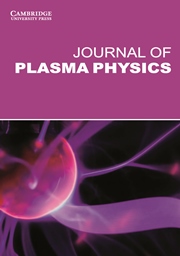Article contents
The effects of electron energy distribution function on the plasma sheath structure in the presence of charged nanoparticles
Published online by Cambridge University Press: 17 March 2020
Abstract
The effects of the electron energy distribution function (EEDF) on the structure of a dusty plasma sheath are investigated. Here, it is assumed that the electrons obey a Druyvesteyn-type distribution with a parameter  $x$ controlling the shape of the EEDF. The Druyvesteyn-like distribution tends to a Maxwellian distribution as
$x$ controlling the shape of the EEDF. The Druyvesteyn-like distribution tends to a Maxwellian distribution as  $x$ varies from 2 to 1. Using the orbital motion limited theory, the incident electron current on the dust is evaluated for a given
$x$ varies from 2 to 1. Using the orbital motion limited theory, the incident electron current on the dust is evaluated for a given  $x$. The results of numerical simulations are compared with those of a Maxwellian distribution. It was found that the sheath dynamics depends strongly on the magnitude of
$x$. The results of numerical simulations are compared with those of a Maxwellian distribution. It was found that the sheath dynamics depends strongly on the magnitude of  $x$. The sheath thickness increases monotonically with increasing
$x$. The sheath thickness increases monotonically with increasing  $x$. However, the absolute dust charge decreases and, as a result, the accelerating ion drag force is weakened and thus the dust number density is enhanced. For a plasma with a Druyvesteyn-like distribution, the Bohm speed is a function of
$x$. However, the absolute dust charge decreases and, as a result, the accelerating ion drag force is weakened and thus the dust number density is enhanced. For a plasma with a Druyvesteyn-like distribution, the Bohm speed is a function of  $x$ and increases with increasing
$x$ and increases with increasing  $x$.
$x$.
Keywords
- Type
- Research Article
- Information
- Copyright
- © Cambridge University Press 2020
References
- 6
- Cited by


